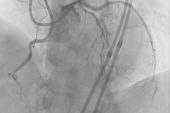Global CTO Crossing Algorithm Seeks to Standardize Procedure
While local differences will remain based on equipment and expertise, the tool aims to streamline training and research.

More than 100 operators from 50 countries have teamed up to develop a unique algorithm for crossing chronic total occlusion (CTO) lesions, with the aim of standardizing techniques and helping operators learn how to manage these difficult-to-treat lesions.
Until now, three similar CTO algorithms have primarily been used—the EuroCTO, hybrid, and Asia Pacific—and the global algorithm merges the best of primary regional protocols, co-author Emmanouil S. Brilakis, MD, PhD (Minneapolis Heart Institute and Minneapolis Heart Institute Foundation, MN), told TCTMD.
Led by Eugene B. Wu, MD (Chinese University Hong Kong, Hong Kong), the group published their new algorithm in the August 24, 2021, issue of the Journal of the American Heart Association.
A 2019 consensus document, headed up by Brilakis, highlighted the concept that “all CTO crossing techniques are valuable in the right setting,” Wu and colleagues note. “Development of a unified global CTO crossing algorithm could significantly facilitate decision-making and CTO PCI teaching across various geographies and improve the safety, reproducibility, and efficiency of the procedure.”
Together, four CTO PCI experts from North America, Europe, and Asia created an initial draft then sought input from others around the world.
Most of the authors have been involved in influential CTO studies and algorithms in the past, and hence “this is a prime example of people getting together and creating something in common that can be applied by everyone and hopefully translate into outcomes,” Brilakis said.
“The whole point of this effort was to get everyone to agree on the key parts. There's always going to be some differences in local preferences, which is fine,” he continued. “This is an attempt to standardize and make it globally applicable the way we approach CTOs right now.”
The crossing algorithm includes the following 10 steps:
- Use of dual angiography
- Careful angiographic review focusing on proximal cap morphology, occlusion segment, distal vessel quality, and collateral circulation
- Approaching proximal cap ambiguity using IVUS, retrograde, and move-the-cap techniques
- Approaching poor distal vessel quality using the retrograde approach and bifurcation at the distal cap by use of a dual-lumen catheter and IVUS
- Feasibility of retrograde crossing through grafts and septal and epicardial collateral vessels
- Antegrade wiring strategies
- Retrograde approach
- Changing strategy when failing to achieve progress
- Considering performing an investment procedure if crossing attempts fail
- Stopping when reaching high radiation or contrast dose or in case of long procedural time, occurrence of a serious complication, operator and patient fatigue, or lack of expertise or equipment
While the existing algorithms have served CTO operators well, Brilakis said the time has come for even more standardization. One of the challenges trainees have faced, for example, is “getting confused” by which algorithm to follow, he said. “Having one commonly accepted is easier for people to learn. Also, it makes it easier for research endeavors down the line. When there is a commonly accepted pattern, then one can analyze better if people approach a CTO based on what one would expect based on this broadly accepted algorithm.”
Local differences based on availability of equipment and variations in expertise will still exist, Brilakis acknowledged. For instance, he said, “in Asia, there is excellent wiring skills as well as emphasis on how you manipulate the wire. Also, there is the issue of cost. In the US, the equipment for dissection reentry is much more cost-effective than in other countries, so people have much more experience with doing dissection reentry [there].”
However, Brilakis added, “what this does is provide a common background that is accepted for approaching these lesions.” There is flexibility built in, as well, and he advised operators to customize their crossing strategy based on what they are familiar with, their equipment, and what they think is more likely to be successful on the first try.
Notably, this algorithm is only to be used on patients for whom the decision has already been made to undergo CTO PCI, as the indications for treatment still remain controversial—some say the procedure should be used for symptom relief, but others say it is only warranted in extensive ischemia or as a way to prevent hard endpoints. “This is not about indication,” Brilakis stressed. “This is about how to do it once it's decided to be done.”
He hopes to see this algorithm embraced by CTO operators worldwide. “People who are already doing [CTO PCI] may want to consider their current approach and see if it fits what is on the global algorithm,” Brilakis advised. “And then down the line we'll see if this compares favorably with the previous algorithms, [and] whether it can increase success more or potentially even decrease complications. Obviously, we need to have some more data to see if this makes sense and provides improvement in success and complication rates.”
Yael L. Maxwell is Senior Medical Journalist for TCTMD and Section Editor of TCTMD's Fellows Forum. She served as the inaugural…
Read Full BioSources
Wu EB, Brilakis ES, Mashayekhi K, et al. Global chronic total occlusion crossing algorithm: JACC state-of-the-art review. J Am Coll Cardiol. 2021;78:840-853.
Disclosures
- Wu reports receiving research funding from Abiomed, OrbusNeich, Asahi Intecc; has received consulting honoraria from Boston Scientific and Abbott Vascular; is a member of the board of directors for APCTO Club; and holds stock in Abbott Vascular.
- Brilakis reports receiving consulting and speaker honoraria from Abbott Vascular, the American Heart Association (associate editor, Circulation), Amgen, Biotronik, Boston Scientific, Cardiovascular Innovations Foundation (board of directors), ControlRad, CSI, Ebix, Elsevier, GE Healthcare, InfraRedx, Medtronic, Siemens, and Teleflex; has received research support from Regeneron and Siemens; is an owner of Hippocrates; and is a shareholder in MHI Ventures.




Comments